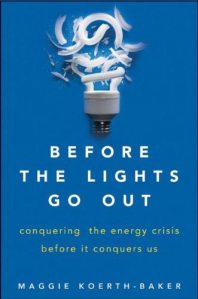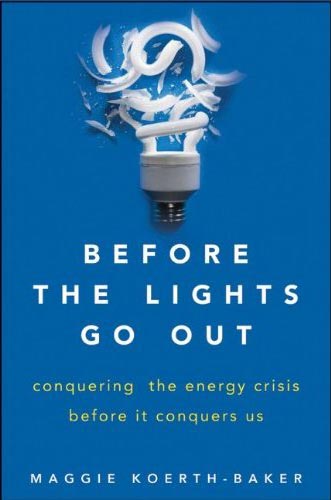This is an excerpt from Maggie Koerth-Baker’s new book, Before the Lights Go Out: Conquering the Energy Crisis Before It Conquers Us. We’ve also got an interview with the author, in which she talks about finding common ground with climate deniers, the value of individual action in fixing a broken energy system, and the price of gas.
 We could theoretically put climate change on pause right now — lock in atmospheric accumulation of carbon dioxide at its current level and stop the process from getting worse. Efficiency and conservation could do that. But you wouldn’t like the outcome very much, says Stephen Pacala, the director of the Carbon Mitigation Initiative at Princeton University. To solve the problem that way, we’d have to adopt a very strict and meager rationing of greenhouse gas emissions — just one ton of emissions per year, per person.
We could theoretically put climate change on pause right now — lock in atmospheric accumulation of carbon dioxide at its current level and stop the process from getting worse. Efficiency and conservation could do that. But you wouldn’t like the outcome very much, says Stephen Pacala, the director of the Carbon Mitigation Initiative at Princeton University. To solve the problem that way, we’d have to adopt a very strict and meager rationing of greenhouse gas emissions — just one ton of emissions per year, per person.
A ton sounds like a lot, but in this case, it’s not. The resulting budget would look less like a prudent belt-tightening and more like the work of Ebenezer Scrooge, pre-Christmas. One ton of greenhouse gas emissions buys a year’s worth of heat for one average home in the United States, Pacala says. That’s not including electricity, clothes, food, or transportation. Do you travel a lot for business? Maybe you could spend your one ton of emissions on airline flights instead. On that yearly budget, you can afford to fly 10 thousand miles in coach. Of course, again, that leaves you with no food to eat, no clothes to wear, and no house to come home to.
So, there’s saving the future, and then there’s actually being able to enjoy the future we saved. If you want the latter, it’s clear that simply reducing energy demand won’t be enough. In fact, no one change will be enough. Pacala made this point about efficiency and conservation not because he’s a killjoy or because he doesn’t think those efforts are worthwhile. He made it because he’s convinced that no single change can solve our energy problems.
You can’t do it only with efficiency and conservation. You can’t do it with nuclear power alone. You can’t do it with only biofuels or wind and solar generation or a smart grid.
Instead, Pacala and many other experts say that you’ll need all of those elements. As with scientific theories, many little solutions have to come together to create one big Solution. In some ways, the little solutions can’t work at all if they aren’t used in tandem with others. A good way to think about the future of energy is to imagine it as a three-legged stool. To keep it from wobbling or breaking, you need a strong foundation in three key areas—energy efficiency, energy infrastructure, and alternative generation, all three at once. To get the most environmental benefit from energy efficiency, you also need to have alternative generation. America’s electric infrastructure needs smart grid technology, natural gas, cleaner coal, and nuclear power to stay stable during the next few decades. Alternative generation needs a smart grid to work, and it needs efficiency to lower electric demand.
All of the parts support one another. If we really want to reduce our fossil fuel use by 20 quadrillion BTUs a year in only 20 years, then we need to embrace as many ways to change energy as the Climate & Energy Project embraced reasons to care about energy.
More important, this is how we have to do it if we want to make a difference in the time we have. There are many reasons to care about the future of energy, and I think we can find enough common ground to get the ball rolling by respecting everyone’s concerns. Frankly, given a perfect world, I’d be happy to just sit back and let people move on energy change at their own pace, but the world isn’t perfect. Between climate change and fossil fuel peaks, there’s good evidence that we can’t afford to let the future of energy slowly evolve. The risks are too big, and they get bigger the longer we wait.
We don’t know exactly when oil will peak, and the economic fallout is likely to be worse and last longer the less prepared we are for it. The climate is already changing. The more greenhouse gases we add to the atmosphere, the hotter the planet will get, and the longer the effects will last — even after we do finally reduce our reliance on fossil fuels. That’s because the excessively high levels of greenhouse gasses currently in our atmosphere won’t quickly drop back to normal once we stop adding to them, just as your body doesn’t instantly sober up when you pass on a seventh beer. The impact of climate change — the hangover — will take even longer to vanish.
Even if we somehow stopped burning fossil fuels tomorrow, researchers say we could still be living with the results of choices we’ve already made for a thousand years. The longer we wait, the bigger the problem gets and the harder it is to do anything about.
This brings me to another key lesson about energy, something I hinted at earlier but didn’t really shout about yet: you can’t do this yourself. Coordinating lots of different solutions on the level of systems, as fast as we possibly can is something that requires a group effort directed by policy, not volunteerism.
Think about it this way: energy is like public health. There are small acts you can perform to protect yourself from disease, choices you can make that have a minor impact on your little corner of the world. Yet these actions alone won’t prevent you from getting a disease, and they definitely won’t solve the problem on a larger scale.
Smallpox was a scourge that humankind is better off without, but we didn’t get rid of it because individuals decided to quarantine themselves. You don’t fight a systemic problem on an individual level. Eradicating smallpox required us to make big societal investments in the research and development of vaccines and in the infrastructure to get those vaccines to every corner of the globe.
Individuals mattered in that process: people did the research, people administered vaccines, and people chose to get vaccinated. The plan worked, however, because those people were acting as a part of something bigger. On their own, with nothing to connect their efforts, individuals trying to eradicate smallpox couldn’t have made a difference, even if lots of individuals were separately working on it at the same time.
Energy is a system, just like public health. Changing that system will require something bigger than what you and I can do at home and even bigger than what one metro can do during the course of a year.
That doesn’t mean there’s no point to changing our personal lifestyles. My husband and I have made a number of changes because we are concerned about energy. We bought a house on a heavily traveled bus route, so that we only have to own one car. The house we chose is smaller than average, on a small lot, so that it takes a lot less energy to heat it, and we can easily take care of the lawn with a push mower, instead of a gas-powered one. Our house is also older. Basically, we recycled, rather than building new, and we’ve updated it to make it more energy efficient. We opted into a program from our utility company that allows us to pay a little extra every month to help fund wind power projects. We recycle. We compost during the summer. When we have to buy appliances, we choose Energy Star.
Since my husband started working as an energy consultant, we’ve made a lot of little changes to the way we live. We do this because energy is important to us, and we want to express those values. Yet we also know that our actions aren’t really helping the United States get off fossil fuels.
My husband and I certainly aren’t the most energy-conscious Americans ever, but even if we were, that wouldn’t change the fact that individual actions aren’t the solution. In Powering the Dream, journalist Alexis Madrigal’s book about the history of alternative energy technologies and what it can teach us about energy today, Madrigal cites an MIT study that does a very good job of expressing the limits of individual choice. In the study, researchers looked at the energy impact of eighteen different types of American lifestyles, ranging from a homeless person and a Buddhist monk to a U.S. senator and a multimillionaire. The homeless person and the monk used a lot less energy than the senator and the multimillionaire did, to be sure. Yet when you take the energy they did use and add to it the energy embodied in our shared systems — roads, schools, the military, and so on — even the Americans with the most Spartan lifestyles still consumed more than double the average global energy use.
In other words, you could beat your own lifestyle into submission with a ten-foot club — you could do more to save the planet than almost anyone is willing to voluntarily do — and it still wouldn’t be enough.
This isn’t about you, and it isn’t about me. It’s about the systems that we share. The answer to the question “So now what?” has to be “Now we change the systems.” No other option makes sense.



